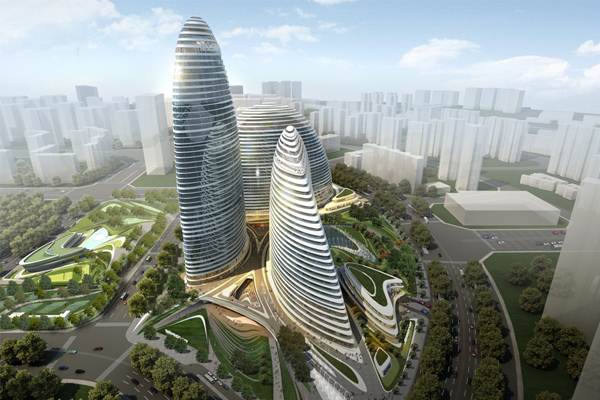The Changing face of Beijing architecture- Wangjing Soho
- By William Wang
 0 Comment(s)
0 Comment(s) Print
Print E-mail
CRI, December 5, 2011
E-mail
CRI, December 5, 2011
|
Artist's rendering of the Wangjing Soho project [Photo: courtesy of Zaha Hadid Architects] |
Between the Capital airport and downtown Beijing lies a lengthy stretch of nondescript landscape consisting of a few trees and buildings. But in the next year or so, a beacon of three rounded forms will be seen reaching upwards as high as 200 metres, likely dominating the horizon. This will be , intentionally set outside of the Beijing core where its impact on the surrounding area could be strong, if not transformational.
Wangjing Soho is the sister project to Galaxy Soho. Each one is a cluster of rounded towering shapes, but Wangjing makes a more direct reference to mountainous landscapes, reminiscent of the peaks of Guilin. The three offices and retail towers respond to the rounded triangle of ground they lie on, while creating an inviting space at their centre. In a city where rectangular block style buildings are the norm, Wangjing Soho will stand out from afar.
"After the year 2000, the country was further opening up and absorbing ideas, new ways of realizing new possibilities," project director Satoshi Ohashi explains. "Now post-Olympics is a period where we're thinking of new possibilities. What do we really need [considering] the scale of China's growth, and speed?" So now is a period of growth and innovation, and architectural firm Zaha Hadid Architects want to ensure that Wangjing Soho reflects that. "People call it 'experimental,' says project director Satoshi Ohashi, "but I don't necessarily think it's experimental… It's part of the condition and the dynamics that are happening now.
Zaha Hadid Architects have won a score of architectural competitions and awards for various projects of various sizes across the globe. ZHA's designs tend to favour swooping lines as opposed to rigid ones, creating deceptively simple and elegant forms in the Wangjing Soho project. Horizontal planes allow for the buildings subtle curves to be coaxed out of the shadows, inviting you to get closer to them. "Even though they know it's a modern new building, people are sensing something that is more human or tangible," says Ohashi.
Although the initial design of two buildings was rejected for being too tall, the new design of three slightly smaller buildings has been widely well-received. Ohashi agrees that the three building design is an improvement from the two building design, appreciating the central space created between them. Still, there's no denying that the project is physically and financially massive. Ohashi affirms that the large size is an important aspect of the project. Home to a quarter of a million residents, Wangjing remains an area without a central focus or a clear identity. In terms of commerce, it is still developing. Wangjing Soho by nature of its proportion and design seeks to help foster a central identity, visible from across the region.
At present, Ohashi recognizes that there is no structure like this in Wangjing, but feels that the potential to grow that market is exciting. "This is a different market, so we have to create a new vision. We have to create the context… Some buildings are plugged in to the city, and others have to nurture that part. And I think the Wangjing project is going to develop that area and hopefully raise the standard of the living and working environment."
Wangjing Soho's buildings may look luxurious, but they have no intention of limiting themselves to the elite classes. "They're not just for upper end market," Ohashi explains, "Actually they're trying to respond to the middle area. Because there are more people available. I think these projects do create change. As they get developed, the surrounding area will change or get developed. Hopefully in a good way." Ohashi guesses that it would be five years or so for significant change to come to the neighbouring areas."
The aspirations of Wangjing Soho are bold, but it's certain that it's creation will bring about extensive changes in unforeseeable ways. "It's exciting to be here in this period of time, in this region because you sense a lot of dynamics... Obviously when you have all this change and movement and this mass of people…hopefully it [will change] in a good way. That's the big question. How they can keep controlling or sustaining that? Of course there are environmental issues, human issues and obviously economic issues and so how do they keep that going without disrupting that in a bad way. I think that's the big challenge. But to be part of that, the ability of creating vision is very exciting. And that's why we're here."
Galaxy Soho will be located midway between the city and airport. It will open in 2014.







Go to Forum >>0 Comment(s)